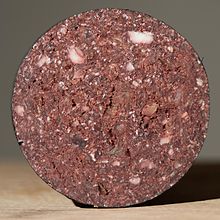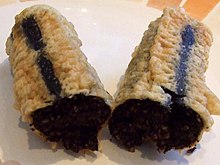
Cajun cuisine is a style of cooking developed by the Cajun–Acadians who were deported from Acadia to Louisiana during the 18th century and who incorporated West African, French and Spanish cooking techniques into their original cuisine.

Haggis is a savoury pudding containing sheep's pluck, minced with chopped onion, oatmeal, suet, spices, and salt, mixed with stock, and cooked while traditionally encased in the animal's stomach though now an artificial casing is often used instead. According to the 2001 English edition of the Larousse Gastronomique: "Although its description is not immediately appealing, haggis has an excellent nutty texture and delicious savoury flavour".

A sausage is a type of meat product usually made from ground meat—often pork, beef, or poultry—along with salt, spices and other flavourings. Other ingredients, such as grains or breadcrumbs may be included as fillers or extenders.

Head cheese or brawn is a cold cut terrine or meat jelly that originated in Europe. It is made with flesh from the head of a calf or pig, typically set in aspic, and usually eaten cold, at room temperature, or in a sandwich. Despite its name the dish is not a cheese and contains no dairy products. The parts of the head used vary, and may include the tongue but do not commonly include the brain, eyes or ears. Trimmings from more commonly eaten cuts of pork and veal are often used, and sometimes the feet and heart, with gelatin added as a binder.

Pudding is a type of food. It can be either a dessert, served after the main meal, or a savoury dish, served as part of the main meal.

A blood sausage is a sausage filled with blood that is cooked or dried and mixed with a filler until it is thick enough to solidify when cooled. Most commonly, the blood of pigs, sheep, lamb, cow, chicken, or goose is used.

Scrapple, also known by the Pennsylvania Dutch name Pannhaas, is traditionally a mush of pork scraps and trimmings combined with cornmeal and wheat flour, often buckwheat flour, and spices. The mush is formed into a semi-solid set loaf, and slices of the scrapple are then pan-fried before serving. Scraps of meat left over from butchering, not used or sold elsewhere, were made into scrapple to avoid waste. Scrapple is primarily eaten in the southern Mid-Atlantic region of the United States.
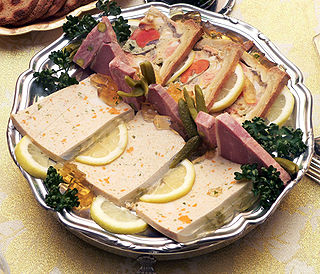
Offal, also called variety meats, pluck or organ meats, is the internal organs of a butchered animal. The word does not refer to a particular list of edible organs, and these lists of organs vary with culture and region, but usually exclude skeletal muscle. Offal may also refer to the by-products of milled grains, such as corn or wheat.

A Scotch egg is a boiled egg wrapped in sausage meat, coated in breadcrumbs and baked or deep-fried.

Chitterlings, sometimes spelled chitlins or chittlins, are the large intestines of domestic animals. They are usually made from pigs' intestines. They may also be filled with a forcemeat to make sausage. Intestine from other animals, such as cow, lamb, goose, and goat is also used for making chitterling.

White pudding, oatmeal pudding or mealy pudding is a meat dish popular in the British Isles.

Red pudding is a meat dish served mainly at chip shops in some areas of Scotland. Red pudding is associated with the east of Scotland, particularly Fife, but has become less common in recent years. Its main ingredients are beef, pork, pork rind or bacon, suet, rusk, wheat flour, spices, salt, beef fat and colouring.

Peasant foods are dishes eaten by peasants, made from accessible and inexpensive ingredients.

Boudin, black pudding in English, is essentially pig’s guts filled with blood and other ingredients, such as onions, spinach, etc. The added ingredients vary in French, Luxembourgish, Belgian, Swiss, Québec, Acadian, Aostan, Louisiana Creole, and Cajun cuisine.
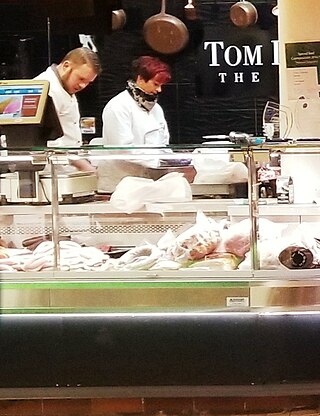
Drisheen is a type of blood pudding made in Ireland. It is distinguished from other forms of Irish black pudding by having a gelatinous consistency. It is made from a mixture of cow's, pig's or sheep's blood, milk, salt and fat, which is boiled and sieved and finally cooked using the main intestine of an animal as the sausage skin. The sausage may be flavoured with herbs, such as tansy, or served with tansy sauce. The recipe for drisheen varies widely from place to place and it also differs depending on the time of year. Drisheen is a cooked product but it usually requires further preparation before eating. How this is done varies widely from place to place.

A full breakfast is a substantial cooked breakfast meal, often served in Great Britain and Ireland. The typical ingredients are bacon, sausages, eggs, black pudding, baked beans, tomatoes, mushrooms, toast, fried bread and a beverage such as coffee or tea. Hash browns are a common contemporary but non-traditional inclusion. Ingredients may extend beyond these or include regional variants, which may often be referred to by different names depending on the area. While it is colloquially known as a "fry-up" in most areas of the United Kingdom and Ireland, it is usually referred to as a "full English", a "full Irish", "full Scottish", "full Welsh", and "Ulster fry", in England, the Republic of Ireland, Scotland, Wales, and Northern Ireland, respectively.
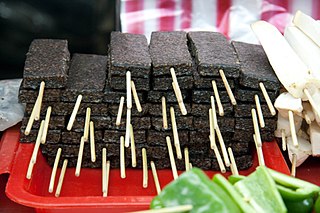
Blood as food is the usage of blood in food, religiously and culturally. Many cultures consume blood, often in combination with meat. The blood may be in the form of blood sausage, as a thickener for sauces, a cured salted form for times of food scarcity, or in a blood soup. This is a product from domesticated animals, obtained at a place and time where the blood can run into a container and be swiftly consumed or processed. In many cultures, the animal is slaughtered. In some cultures, blood is a taboo food.
Sneem Black Pudding is a variety of black pudding produced in Sneem, County Kerry, Ireland.
